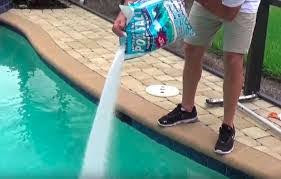If you’ve ever stepped into a saltwater pool, you’ve probably noticed the soft, silky feel of the water and how much gentler it is on your skin and eyes compared to traditional chlorine pools. For many homeowners, switching to a saltwater system feels like a luxury upgrade, but it’s also a practical choice that can simplify maintenance and reduce long-term chemical costs.
Whether you’re a new pool owner or planning pool renovations Houston, understanding what it takes to convert to a saltwater system will help you make an informed decision. In this guide, we’ll walk through the steps, costs, and upkeep of converting your pool to saltwater.
What Is a Saltwater Pool System?
A saltwater pool isn’t completely chlorine-free , instead of manually adding chlorine, it uses a salt chlorine generator to produce chlorine naturally. When you add salt to the water, the generator uses electrolysis to convert that salt into chlorine, sanitizing the pool continuously.
The result is a steady, gentle chlorine level that feels softer on your skin, doesn’t cause strong chemical odors, and generally requires less day-to-day maintenance.
Step-by-Step Process of Converting to Saltwater
1. Test and Prepare Your Existing Pool
Before starting the conversion, test your water chemistry and check your pool’s current equipment. Ensure your pump, filter, and plumbing system are in good condition. If your equipment is old or corroded, it may need upgrades before you can safely install a salt system.
2. Choose the Right Salt Chlorine Generator
Not all systems are the same size or strength. Your salt system must match your pool’s volume, usually rated in gallons. A good rule of thumb is to choose a system rated for at least 25–30% more than your pool’s actual capacity to ensure optimal performance.
3. Drain or Balance the Water
Most conversions don’t require a full drain unless your pool has very high stabilizer (CYA) or calcium levels. In most cases, balancing the pH and alkalinity before installation is enough.
4. Install the Salt Chlorine Generator
This is the core of your conversion. The generator consists of two main parts:
The control box (mounted near your pool equipment).
The salt cell (installed in your plumbing line, after the filter and heater).
It’s recommended to have a professional installer handle this step to ensure proper wiring and plumbing.
5. Add Salt
Once your system is installed, add the required amount of pool-grade salt (sodium chloride). The amount depends on your pool size, but typically ranges between 200–400 pounds for an average residential pool.
Most systems operate best at a salt concentration of 3,000–3,500 ppm (parts per million).
6. Start the System and Test
After dissolving the salt (usually within 24 hours), turn on the system and let it start generating chlorine. Test the water regularly for the first week to ensure the chlorine production and salt levels are stable.
How Much Does It Cost to Convert to Saltwater?
The cost to convert a pool to saltwater can vary depending on pool size, existing equipment, and local labor rates.
Here’s a breakdown of typical expenses:
Item Average Cost
Salt chlorine generator (system) $1,000 – $2,000
Installation (professional labor) $300 – $800
Salt (initial fill) $50 – $150
Electrical upgrades (if needed) $200 – $500
Total estimated cost: $1,500 – $3,500 for most residential pools.
If you’re undergoing pool renovations Houston, combining your salt conversion with resurfacing or equipment upgrades can save on installation costs and labor fees.
Ongoing Upkeep and Maintenance
Saltwater pools are often marketed as “low-maintenance,” but that doesn’t mean maintenance-free. You’ll still need to check water chemistry and equipment regularly.
Routine tasks include:
Testing chlorine, pH, and salt levels weekly.
Cleaning the salt cell every 3–6 months to remove calcium buildup.
Adding salt as needed (usually a few bags per season).
Monitoring stabilizer (CYA) to prevent chlorine loss from sunlight.
The annual cost of upkeep is around $100–$200, compared to $300–$500 for traditional chlorine pools.
Pros and Cons of a Saltwater Pool
Advantages
Softer, gentler water for skin and eyes.
Lower annual chemical costs.
Consistent chlorine levels, no chemical “shocks.”
Minimal chlorine smell and residue.
Disadvantages
Higher upfront cost for equipment.
Requires occasional cell cleaning and replacement (every 3–7 years).
Salt can be mildly corrosive to metal fixtures if not maintained.
FAQs About Converting to Saltwater
- Will saltwater damage my pool equipment?
If maintained properly, no. Modern pool components are designed to resist corrosion. Regular cleaning and balanced water chemistry protect your equipment long-term.
- How often should I add salt?
Most pools need salt top-ups once or twice a year, depending on rain, backwashing, and splash-out.
- Can I do the conversion myself?
It’s possible for experienced DIYers, but hiring a professional ensures proper installation and wiring. Many homeowners include this step as part of pool renovations Houston for convenience and warranty coverage.
- Do saltwater pools still use chlorine?
Yes, the system converts salt into chlorine automatically, maintaining steady sanitation without manual chemical dosing.
- Does the water taste salty?
No, it contains about one-tenth the salt of ocean water, similar to a tear drop. Most swimmers can’t taste it at all.
Final Words
Converting your pool to saltwater is an investment that pays off in comfort, convenience, and long-term savings. The water feels smoother, requires fewer chemicals, and stays crystal clear with minimal effort.
Whether you’re building a new pool or considering pool renovations Houston, a saltwater system can be the perfect upgrade. With proper installation, regular maintenance, and balanced chemistry, you’ll enjoy years of relaxing, hassle-free swimming.




